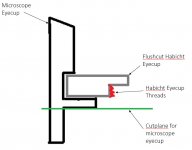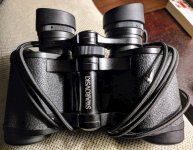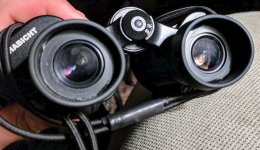Please forgive my seemingly bad form of quoting myself, but the OP requested via PM that I do provide an update to this. Figured it would help more people if I shared publicly.
In reading this forum, there have been a few solutions to the problem, and it is somewhat of a problem, that the eyecups are really just inadequately short for proper eye relief. Granted, this can be mitigated by using the "good technique" I mentioned above, which also helps hold most any binocular more stable, but it isnt always convenient as it doesnt provide a quick or easy way to consistently "mount" the optics to your face.
The solutions noted on the forum that I've taken note of are the following
- Use the GA eyecups
- Use the winged swaro aftermarket eyecups
- Use bicycle innertube bulked up around stock eyepiece
Each of these have their own benefits and annoyances.
GA eyecups require getting these or scavenging / swapping them from another pair of bins and also offer a less stylish option.
Winged eyecups from swaro are pretty pricey and require the use of their new rainguard (i think?) since they're likely too large for the stock one on the leather habicht. Also, I wasnt really wanting big wings like that as sometimes they've created a tendency to fog the ocular lens for me.
Lastly, the bike innertube is a great option on the cheap, but it looked sort of bulky and odd. Might also have trouble fitting the stock rain guard.
The road I ventured down was looking at microscope accessories since they too have binocular optics on some units. What I found was a nice set of soft rubber slip on eyecups for under 10$ shipped. As it turns out, they are very very slightly winged and are thin\flexible enough that it still allows use of the stock rain guard, though it isnt as free sitting as with the smaller stock eyecups.
Now it's simple enough to raise the bins directly to the eye sockets and they block pretty much all of the stray light and, for my face at least, fit perfectly in my eye sockets. Highly recommend these.
https://www.amazon.com/AmScope-EG-S...005ORIVQY/ref=cm_cr_arp_d_product_top?ie=UTF8
Hopefully it's ok I linked to amazon, if not, please let me know and I can remove the link to these and replace with the product name/description so people can find them.






